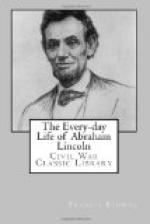“It was late in the evening,” continues General Viele, “when we arrived at Fortress Monroe.... Answering the hail of the guard-boats, we made a landing, and the Secretary of War immediately despatched a messenger for General Wool, the commander of the fort; on whose arrival it was decided to consult at once with Admiral Goldsborough, the commander of the fleet, whose flag-ship, the ‘Minnesota,’ a superb model of naval architecture, lay a short distance off the shore. The result of this conference was a plan to get up an engagement the next day between the ‘Merrimac’ and the ‘Monitor,’ so that during the fight the ‘Vanderbilt,’ which had been immensely strengthened for the purpose, might put on all steam and run her down. Accordingly, the next morning, the President and party went over to the Rip Raps to see the naval combat. The ‘Merrimac’ moved out of the mouth of the Elizabeth river, quietly and steadily, just as she had come out only a few weeks before when she had sunk the ‘Congress’ and the ‘Cumberland.’ She wore an air of defiance and determination even at that distance. The ‘Monitor’ moved up and waited for her. All the other vessels got out of the way to give the ‘Vanderbilt’ and the ‘Minnesota’ room to bear down upon the rebel terror as soon as she should clear the coast line. It was a calm Sabbath morning, and the air was still and tranquil. Suddenly the stillness was broken by the cannon from the vessels and the great guns from the Rip Raps, that filled the air with sulphurous smoke and a terrific noise that reverberated from the fortress and the opposite shore like thunder. The firing was maintained for several hours, but all to no purpose; the ‘Merrimac’ moved sullenly back to her position. It was determined that night that on the following day vigorous offensive operations should be undertaken. The whole available naval force was to bombard Sewall’s Point, and under cover of the bombardment the available troops from Fortress Monroe were to be landed at that point and move on Norfolk. Accordingly, the next morning a tremendous cannonading of Sewall’s Point took place. The wooden sheds at that place were set on fire and the battery was silenced. The ‘Merrimac,’ coated with mail and lying low in the water, looked on but took no part. Night came on, and the cannonading ceased. It was so evident that the ‘Merrimac’ intended to act only on the defensive, and that as long as she remained where she was no troops could be landed in that vicinity, that they were ordered to disembark. That night the President, with the Secretary of War and the Secretary of the Treasury, went over on the ‘Miami’ to the Virginia shore, and by the light of the moon landed on the beach and walked up and down a considerable distance to assure himself that there could be no mistake in the matter. How little the Confederacy dreamed what a visitor it had that night to the ‘sacred soil.’”




